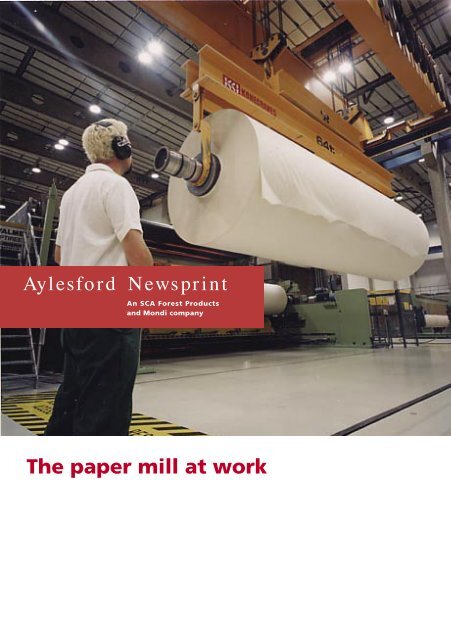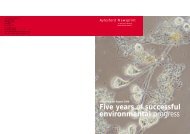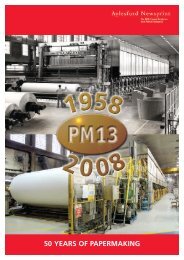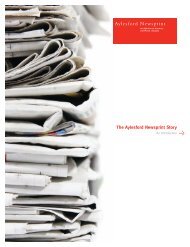The paper mill at work - Aylesford Newsprint
The paper mill at work - Aylesford Newsprint
The paper mill at work - Aylesford Newsprint
- No tags were found...
You also want an ePaper? Increase the reach of your titles
YUMPU automatically turns print PDFs into web optimized ePapers that Google loves.
An SCA Forest Productsand Mondi company<strong>The</strong> <strong>paper</strong> <strong>mill</strong> <strong>at</strong> <strong>work</strong>
<strong>The</strong> Process<strong>The</strong> Recycled Fibre Store<strong>The</strong> Mill uses mixed recovered news<strong>paper</strong> and magazines and segreg<strong>at</strong>edmagazines which are stored in the Recycled Fibre Store prior to being loadedby one of our two shovels for continuous supply to the fibre prepar<strong>at</strong>ion plantfor pulping and manufacture.<strong>The</strong> Recycled Fibre Store is a 72,000m2 warehouse storing all of the incomingrecovered news<strong>paper</strong>s and magazines ready for recycling. It can hold upto 10,000 tonnes of m<strong>at</strong>erial <strong>at</strong> any one time, sufficient to supply our 2<strong>paper</strong> machines for more than one week’s production. As the <strong>mill</strong> oper<strong>at</strong>escontinuously it is important th<strong>at</strong> good stock levels are maintained to keep the<strong>mill</strong> running. A team of five people deal with an average of 100 vehicles perday which deliver the recovered m<strong>at</strong>erials between 6.30 am and 9 pm and withone person <strong>work</strong>ing overnight ensures th<strong>at</strong> the <strong>mill</strong> is kept supplied with <strong>paper</strong>.Recovered news<strong>paper</strong>s and magazines arrive here <strong>at</strong> the <strong>mill</strong> in large vehicleswith a bar coded delivery note; the vehicle is weighed and moves to theRecycled Fibre Store where the delivery note is scanned to record the detailsof supplier, weight and quality. <strong>The</strong> vehicle is then directed to one of four bays,each of which has the capacity to hold up to 2,500 tonnes of recovered <strong>paper</strong>.<strong>The</strong> vehicle is inspected during unloading for contaminants which, if found,are recorded on a handheld computer system for quality grading of the load.<strong>The</strong>re are no <strong>paper</strong> sorting facilities and by <strong>work</strong>ing with suppliers good qualitym<strong>at</strong>erial is delivered. After unloading the vehicle leaves the store and maycollect a load of newsprint for pressroom delivery.<strong>The</strong> Fibre Prepar<strong>at</strong>ion Plant<strong>The</strong> Fibre Prepar<strong>at</strong>ion Plant (FPP) uses the wood fibres in recovered news<strong>paper</strong>sand magazines to produce a clean, bright pulp for manufacturing newsprint.<strong>The</strong> plant has 14 stages which include: pulping, cleaning, screening, thickening,dispersion, bleaching, de-inking and washing.<strong>The</strong> <strong>paper</strong> <strong>mill</strong> <strong>at</strong> <strong>work</strong>
News<strong>paper</strong>s and magazines from the recycled fibre store enter two horizontaldrum pulpers in the FPP from two conveyors. <strong>The</strong> pulpers are two large longrot<strong>at</strong>ing, sloping tubes and could be compared to two really big washingmachines on a slow wash cycle. W<strong>at</strong>er and Sodium Silic<strong>at</strong>e are added and thepulper contents are then gently tumbled along the length of the pulper. <strong>The</strong>fibres swell loosening the ink particles and the tumbling action separ<strong>at</strong>es thefibres. Screening separ<strong>at</strong>es the fibres and w<strong>at</strong>er from large contamin<strong>at</strong>es suchas cans, plastic bottles and free magazine gifts which are ejected onto aconveyor belt for disposal.<strong>The</strong> next, or second, stage of the cleaning is the cyclone screens which removesmaller contaminants. Lighter particles such as plastics are removed by screeningand heaver items such as staples and glass are removed by centrifugal forcesin the lower cone section of the cyclone screens. <strong>The</strong> following cleaning stageof the process is ink removal. Most news<strong>paper</strong>s and magazines are printedwith oil-based inks, which are hydrophobic (they don’t like w<strong>at</strong>er) and we usethis characteristic to separ<strong>at</strong>e the ink from the <strong>paper</strong> fibres by adding soap.Compressed air is used to form soap bubbles and, because the ink sticks to thebubbles as they flo<strong>at</strong> to the surface forming a scum, the ink can be removedmechanically. Following de-inking there is further cyclonic cleaning to removefiner unwanted m<strong>at</strong>erials including plastics, sand and glass. Fine screens removeany remaining small contaminants such as glue particles.Once fine screening is completed the disc filters remove w<strong>at</strong>er to take theconsistency of the pulp from about 0.7% to 12% fibre in w<strong>at</strong>er. <strong>The</strong> w<strong>at</strong>erremoved is recycled and used again in the FPP. <strong>The</strong> roll presses remove morew<strong>at</strong>er taking the pulp consistency to about 30% fibre in w<strong>at</strong>er. Hydrogenperoxide is all added to brighten the fibres and the m<strong>at</strong>erial is he<strong>at</strong>ed toabout 85oc. <strong>The</strong> pulp enters the dispergers to thoroughly mix and disperse anyremaining contaminants and then on to the Brightening tower. <strong>The</strong> pulp enterthe tower <strong>at</strong> the top and falls slowly to the bottom taking about 20 minutesallowing time to brighten the pulp. <strong>The</strong> pulp is diluted with w<strong>at</strong>erand completes a further stage of de-inking prior to washing and thickeningto approxim<strong>at</strong>ely 30% consistency. <strong>The</strong> pulp is thickened again and then dilutedwith clean recycled w<strong>at</strong>er for storage <strong>at</strong> approxim<strong>at</strong>ely 12% consistency for l<strong>at</strong>er<strong>paper</strong> making.<strong>The</strong> <strong>paper</strong> <strong>mill</strong> <strong>at</strong> <strong>work</strong>
<strong>The</strong> PM14 Paper MachineRecovered news<strong>paper</strong>s and magazines received in the recycled fibre store <strong>at</strong>the <strong>mill</strong> have been converted into a clean pulp in the Fibre Prepar<strong>at</strong>ion Plantand held pending manufacture in tanks as a pulp consisting of clean, brightfibres <strong>at</strong> 12% consistency. This pulp is now ready for <strong>paper</strong> production.<strong>The</strong> pulp is pumped from the de-inked pulp storage towers and diluted to4% fibre in w<strong>at</strong>er for a further six cleaning stages. During this phase verysmall amounts of blue dye are added to assist the final <strong>paper</strong> brightness,also a ‘retention aid’ to assist the fibres to form a <strong>paper</strong> sheet anda de-foamer to remove any remaining soap bubbles.In order to achieve a good form<strong>at</strong>ion of fibres and therefore a strong <strong>paper</strong>sheet, the pulp is diluted with the addition of w<strong>at</strong>er. <strong>The</strong> head box is designedto distribute the fibres evenly across the 10 metre width of the machine andthe <strong>work</strong> of this equipment is to inject the pulp upwards from the base of themachine into the forming section so th<strong>at</strong> the fibres are trapped between twocontinuous woven nylon supports to form a sheet of <strong>paper</strong>. <strong>The</strong> continuouswoven nylon supports are known as the inner and outer wires. W<strong>at</strong>er issqueezed out evenly from both sides of the sheet with the help of a vacuumand a centrifugal force. When the sheet leaves the forming section it iss<strong>at</strong>ur<strong>at</strong>ed with w<strong>at</strong>er, but it has a good and strong form<strong>at</strong>ion. Paper strengthdepends on <strong>paper</strong> form<strong>at</strong>ion and to be strong it needs to have lots of fibreslaying across each other in many directions and therefore, the more consistentthe arrangement of fibres and the stronger the <strong>paper</strong> form<strong>at</strong>ion. <strong>The</strong> pulpis <strong>at</strong> this stage about 20% fibre to 80% w<strong>at</strong>er.<strong>The</strong> <strong>paper</strong> <strong>mill</strong> <strong>at</strong> <strong>work</strong>
<strong>The</strong> sheet leaves the forming section wires and is picked up by a felt in nextstage, the press section. Through the press section the sheet is only supportedon one side by a synthetic felt which has a high holding capacity for w<strong>at</strong>er.<strong>The</strong> sheet is rotary pressed to reduce the w<strong>at</strong>er content by large rolls similarto 4 large mangles, which enables the <strong>paper</strong> sheet to pass through ‘nips’ (verysmall gaps) formed of m<strong>at</strong>ching twin rollers which force w<strong>at</strong>er out of the sheet.<strong>The</strong> felt and rollers draw w<strong>at</strong>er away from the fibre leaving a consistencyof 50% fibre to w<strong>at</strong>er.<strong>The</strong> sheet enters the dryer section of the <strong>paper</strong> making process. This part ofthe process is split into seven drying areas, each fabric carrying the <strong>paper</strong> as itsnakes through rollers filled with steam. <strong>The</strong> area has an enclosed cover (hood)and hot air is pumped into the area above the rollers. <strong>The</strong> combined he<strong>at</strong> fromthe rollers and the hood evapor<strong>at</strong>es w<strong>at</strong>er in the <strong>paper</strong> sheet and cooler wet airis exhausted, some of this is wh<strong>at</strong> can be seen from the motorway when drivingpast the <strong>mill</strong>. Paper leaving the drying section has a moisture content of just9%, the standard amount for newsprint.<strong>Newsprint</strong> is given a surface tre<strong>at</strong>ment and <strong>at</strong> <strong>Aylesford</strong> this is applied byusing soft calendars, a pair of rolls, one with a soft cover, the other an oil filledthermo roll which applies he<strong>at</strong> like an iron.One of the final stages of production is to monitor the characteristics of themanufactured sheet to ensure th<strong>at</strong> customers’ needs are being properly met.Once completed the sheet is tested for its specific weight, thickness, moisturecontent, mineral fillers, <strong>paper</strong> form<strong>at</strong>ion and sheet colour. <strong>The</strong> results of thesetests are fed directly back into earlier manufacturing stages of the processto provide inform<strong>at</strong>ion to allow adjustments to be made to the process.<strong>The</strong> finished sheet is reeled onto machine or ‘jumbo’ reels <strong>at</strong> the end ofthe process. Each machine reel weighs approxim<strong>at</strong>ely 40 tonnes takesabout 1 hour to make and when finished is available to be processedto customer requirements.<strong>The</strong> <strong>paper</strong> <strong>mill</strong> <strong>at</strong> <strong>work</strong>
Additional Mill equipmentEnergy Plant<strong>The</strong> combined he<strong>at</strong> and power plant (CHP) is owned by Npower Cogen andoper<strong>at</strong>ed by <strong>Aylesford</strong> <strong>Newsprint</strong>. It burns gas to produce steam which is usedfor gener<strong>at</strong>ing electricity and l<strong>at</strong>er for drying <strong>paper</strong> in the local <strong>paper</strong> <strong>mill</strong>s.Electricity is supplied to the newsprint manufacturing business, a number oflocal businesses and external customers via the n<strong>at</strong>ional grid. Steam is suppliedfor newsprint manufacture and to SCA Packaging. CHP plants, where bothoutputs are beneficially used, have much higher efficiencies th<strong>at</strong> conventionalgener<strong>at</strong>ing plants and this plant is an important aspect of the <strong>Aylesford</strong><strong>Newsprint</strong> business model.<strong>The</strong> equipment consists of two G.E. Frame Six Gas Turbines, two He<strong>at</strong> RecoverySteam Gener<strong>at</strong>ors (HRSG) and a Back Pressure Steam Turbine. Fuel is burnedin the Gas Turbine to drive the gener<strong>at</strong>ors and produce electricity; the exhaustgases from the Turbine are routed to the HRSG where steam is raised to 61 barg<strong>at</strong> 480 °C. This steam is then used to drive a back pressure Steam Turbine wherea further 13 Mwh of electricity is produced. <strong>The</strong> steam from both the exhaustand extraction ports of the steam turbine is then used in the <strong>paper</strong>makingprocess.With both Gas Turbines running, the scheme produces typically some 93 Mwhof electrical energy and 115 tonnes/hour of steam. <strong>The</strong> <strong>Aylesford</strong> site requiresapproxim<strong>at</strong>ely 66 Mwh of electricity and therefore some 27 Mwhrs is exportedto the n<strong>at</strong>ional grid. <strong>The</strong> exported power is beneficial to the n<strong>at</strong>ional economybecause it avoids the production of energy th<strong>at</strong> could be raised in coal oroil fired Power st<strong>at</strong>ions whose efficiencies are significantly lower than thoseenjoyed <strong>at</strong> <strong>Aylesford</strong>.<strong>The</strong> process residue combustor<strong>The</strong> process residue combustor is designed to burn the process fibrous residuefrom the recycling process for steam production which is then used for bothelectricity gener<strong>at</strong>ing and drying <strong>paper</strong> in <strong>paper</strong> manufacture. This secondary(process waste) recycling is a very important aspect of the <strong>mill</strong>s energy<strong>The</strong> <strong>paper</strong> <strong>mill</strong> <strong>at</strong> <strong>work</strong>
production although is does lead to our most significant emission to air.<strong>The</strong> combustion of <strong>paper</strong> waste is a direct replacement of fossil fuels bya renewable resource.<strong>The</strong> combustor is a bubbling fluidised bed boiler gener<strong>at</strong>ing 26 tonnes/hour ofsteam for use for electrical gener<strong>at</strong>ion and <strong>paper</strong>making process. <strong>The</strong> combustoris designed to burn 200 dry tonnes of process fibrous residue per day. <strong>The</strong>furnace is designed to meet the requirements for dioxin destruction (850degrees C for a 2-second residence) with rapid cooling in the range 400 degreesC to 200 degrees C to prevent reform<strong>at</strong>ion. <strong>The</strong> cooled gases from the boilerpass to a bag filter assembly designed to provide high efficiency reductionof the particul<strong>at</strong>e discharge.About 200 tonnes of ash is collected per day and transferred to two silos;on discharge the ash is conditioned with w<strong>at</strong>er to control the dusting. Ash isdirectly discharged into vehicles without conditioning for supply for recycling.<strong>The</strong> <strong>paper</strong> <strong>mill</strong> <strong>at</strong> <strong>work</strong>
<strong>The</strong> W<strong>at</strong>er Tre<strong>at</strong>ment Plant<strong>The</strong> w<strong>at</strong>er tre<strong>at</strong>ment plant tre<strong>at</strong>s w<strong>at</strong>er for recycling within the plant and cleansthe w<strong>at</strong>er prior to discharge to the River Medway. <strong>The</strong> w<strong>at</strong>er tre<strong>at</strong>ment Plantprocesses approxim<strong>at</strong>ely 16,500m3/day of used w<strong>at</strong>er, mainly from the FibrePrepar<strong>at</strong>ion Plant, PM13 and PM14. Tre<strong>at</strong>ment is normally in two parts thoughthis can be extended to a third element.Primary Tre<strong>at</strong>ment - W<strong>at</strong>er is received from a buffer tower <strong>at</strong> a specified pH and<strong>at</strong> a controlled r<strong>at</strong>e of flow. An aqueous solution of c<strong>at</strong>ionic polyacrylamideis injected before the w<strong>at</strong>er enters three parallel rot<strong>at</strong>ing drum filters toagglomer<strong>at</strong>e the suspended solids and assist drainage. <strong>The</strong> number of filters inservice depends on the level of demand. <strong>The</strong> separ<strong>at</strong>ed suspended solids aredischarged via a chute into a sump and the filtered w<strong>at</strong>er is deposited in theprimary tre<strong>at</strong>ed w<strong>at</strong>er sump. <strong>The</strong> temper<strong>at</strong>ure can be as high as 45 degrees C.<strong>The</strong> w<strong>at</strong>er needs cooling prior to discharge to the river Medway and is cooled toabout 27 degrees C in a single pass open evapor<strong>at</strong>ive cooling tower.Secondary Tre<strong>at</strong>ment - <strong>The</strong> plant consists of seven aer<strong>at</strong>ion tanks, the first twoof which are smaller “selector” tanks. Oxygen is either obtained from a liquidstorage vessel or an oxygen gener<strong>at</strong>or. Two clarifiers are used for separ<strong>at</strong>ion ofthe activ<strong>at</strong>ed sludge from the cleaned w<strong>at</strong>er for discharge to the Medway River.<strong>The</strong> selectors can be run anoxic or aerobic and the time in the aer<strong>at</strong>ion sectionof the plant is about 10 hours. Under normal oper<strong>at</strong>ing conditions the aerobicplant typically removes 85% of the incoming COD and 98% of the BOD, givingBOD figures of less than 10mg/l and CODs of about 250mg/l. <strong>The</strong>se values areconsidered normal for a de-inking <strong>mill</strong> producing newsprint. <strong>The</strong> suspendedsolid level is generally about 15mg/l.Tertiary Tre<strong>at</strong>ment - <strong>The</strong>re are no w<strong>at</strong>er recycling tertiary tre<strong>at</strong>ment stagesbut there is a drum filter available to tre<strong>at</strong> solids from the clarifiers if requiredhowever this is normally by-passed. Solids separ<strong>at</strong>ed in this process aretransferred into a mixed sludge sump. <strong>The</strong> hard COD remaining in the finaleffluent is typically 90% lignin with the remainder being extractives, consistingof chemicals such as waxes, resins and oils, normally from adhesives <strong>at</strong>tached tothe recovered <strong>paper</strong>.<strong>The</strong> <strong>paper</strong> <strong>mill</strong> <strong>at</strong> <strong>work</strong>





